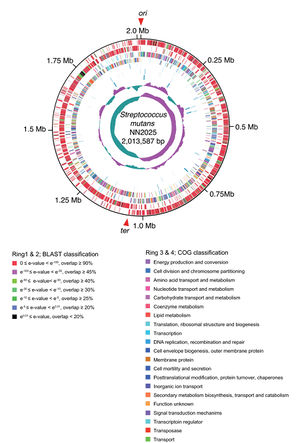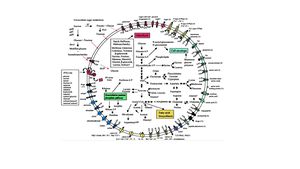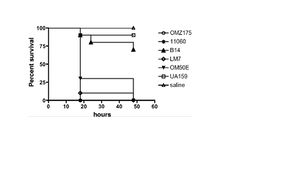Streptococcus mutans: More than Oral Pathogens: Difference between revisions
No edit summary |
|||
| Line 1: | Line 1: | ||
=Introduction= | |||
[[Image:Wehnerj1.jpg|thumb|300px|right|Microscopic image of Gran stained Streptococcus Virus.]] | [[Image:Wehnerj1.jpg|thumb|300px|right|Microscopic image of Gran stained Streptococcus Virus.]] | ||
==History== | |||
Our genetic code isn’t the only thing that is similar to chimpanzees, we also have oral microbes in common. Specifically, we share the firmicute Streptococcus mutans (Fig. 1). These pathogenic microbes are part of the bacteria kingdom and were first isolated from human cavities (carious lessions) in 1924 by Clarke.XX The microbes received the name S. mutans because Clarke believed that the microbes were a mutant version of streptococcus. These microbes are found in all homosapiens and are the main cause of dental decay. As much as 90 % of the world is affected by this pathogenic microbe. XX | Our genetic code isn’t the only thing that is similar to chimpanzees, we also have oral microbes in common. Specifically, we share the firmicute Streptococcus mutans (Fig. 1). These pathogenic microbes are part of the bacteria kingdom and were first isolated from human cavities (carious lessions) in 1924 by Clarke.XX The microbes received the name S. mutans because Clarke believed that the microbes were a mutant version of streptococcus. These microbes are found in all homosapiens and are the main cause of dental decay. As much as 90 % of the world is affected by this pathogenic microbe. XX | ||
<br> | <br> | ||
==Serotypes== | |||
Like many species of bacteria, S. mutans have various strains and serotypes. Serotypes are microorganisms that share a shares a specific substance that cause an immune response.XX Four major serotypes have been discover so far. The serotypes are labeled as c, e, f, and k. The serotype c is considered to be the most common serotype found in plaque, making up about 80 % of the S. microbes population.XX The other three serotypes (e, f, and k) are less common. Up to 20 % of the S. mutans are considered to be e. The smallest groups, f and k, are thought to make up 5 % of the microbe population. Interestingly, the serotype k has only been isolated from Japanese individuals. Recent research has found that e, f, and k may play a hazardous role in infective endocarditis (e and f) and hemorrhagic strokes (k) even though they only make up about a quarter of the population.XX | Like many species of bacteria, S. mutans have various strains and serotypes. Serotypes are microorganisms that share a shares a specific substance that cause an immune response.XX Four major serotypes have been discover so far. The serotypes are labeled as c, e, f, and k. The serotype c is considered to be the most common serotype found in plaque, making up about 80 % of the S. microbes population.XX The other three serotypes (e, f, and k) are less common. Up to 20 % of the S. mutans are considered to be e. The smallest groups, f and k, are thought to make up 5 % of the microbe population. Interestingly, the serotype k has only been isolated from Japanese individuals. Recent research has found that e, f, and k may play a hazardous role in infective endocarditis (e and f) and hemorrhagic strokes (k) even though they only make up about a quarter of the population.XX | ||
<br> | <br> | ||
==Genome Structure== | |||
[[Image:Wehnerj2.jpg|thumb|300px|right|Electron micrograph of the Ebola Zaire virus. This was the first photo ever taken of the virus, on 10/13/1976. By Dr. F.A. Murphy, now at U.C. Davis, then at the CDC.]] | [[Image:Wehnerj2.jpg|thumb|300px|right|Electron micrograph of the Ebola Zaire virus. This was the first photo ever taken of the virus, on 10/13/1976. By Dr. F.A. Murphy, now at U.C. Davis, then at the CDC.]] | ||
| Line 26: | Line 23: | ||
<br> <br> | <br> <br> | ||
=Metabolism= | |||
<br>Include some current research in each topic, with at least one figure showing data.<br> | <br>Include some current research in each topic, with at least one figure showing data.<br> | ||
=Acid Production and Teeth= | |||
<br>Include some current research in each topic, with at least one figure showing data.<br> | <br>Include some current research in each topic, with at least one figure showing data.<br> | ||
=S. mutans "Attachment" to Your Heart= | |||
<br>Include some current research in each topic, with at least one figure showing data.<br> | <br>Include some current research in each topic, with at least one figure showing data.<br> | ||
=The Correlation Between S. mutans and Hemorrhagic Stroke= | |||
<br>Overall paper length should be 3,000 words, with at least 3 figures.<br> | <br>Overall paper length should be 3,000 words, with at least 3 figures.<br> | ||
=Conclusion= | |||
<br>Overall paper length should be 3,000 words, with at least 3 figures.<br> | <br>Overall paper length should be 3,000 words, with at least 3 figures.<br> | ||
=References= | |||
[Sample reference] [http://ijs.sgmjournals.org/cgi/reprint/50/2/489 Takai, K., Sugai, A., Itoh, T., and Horikoshi, K. "''Palaeococcus ferrophilus'' gen. nov., sp. nov., a barophilic, hyperthermophilic archaeon from a deep-sea hydrothermal vent chimney". ''International Journal of Systematic and Evolutionary Microbiology''. 2000. Volume 50. p. 489-500.] | [Sample reference] [http://ijs.sgmjournals.org/cgi/reprint/50/2/489 Takai, K., Sugai, A., Itoh, T., and Horikoshi, K. "''Palaeococcus ferrophilus'' gen. nov., sp. nov., a barophilic, hyperthermophilic archaeon from a deep-sea hydrothermal vent chimney". ''International Journal of Systematic and Evolutionary Microbiology''. 2000. Volume 50. p. 489-500.] | ||
Revision as of 22:35, 24 April 2014
Introduction
History
Our genetic code isn’t the only thing that is similar to chimpanzees, we also have oral microbes in common. Specifically, we share the firmicute Streptococcus mutans (Fig. 1). These pathogenic microbes are part of the bacteria kingdom and were first isolated from human cavities (carious lessions) in 1924 by Clarke.XX The microbes received the name S. mutans because Clarke believed that the microbes were a mutant version of streptococcus. These microbes are found in all homosapiens and are the main cause of dental decay. As much as 90 % of the world is affected by this pathogenic microbe. XX
Serotypes
Like many species of bacteria, S. mutans have various strains and serotypes. Serotypes are microorganisms that share a shares a specific substance that cause an immune response.XX Four major serotypes have been discover so far. The serotypes are labeled as c, e, f, and k. The serotype c is considered to be the most common serotype found in plaque, making up about 80 % of the S. microbes population.XX The other three serotypes (e, f, and k) are less common. Up to 20 % of the S. mutans are considered to be e. The smallest groups, f and k, are thought to make up 5 % of the microbe population. Interestingly, the serotype k has only been isolated from Japanese individuals. Recent research has found that e, f, and k may play a hazardous role in infective endocarditis (e and f) and hemorrhagic strokes (k) even though they only make up about a quarter of the population.XX
Genome Structure
Metabolism
Include some current research in each topic, with at least one figure showing data.
Acid Production and Teeth
Include some current research in each topic, with at least one figure showing data.
S. mutans "Attachment" to Your Heart
Include some current research in each topic, with at least one figure showing data.
The Correlation Between S. mutans and Hemorrhagic Stroke
Overall paper length should be 3,000 words, with at least 3 figures.
Conclusion
Overall paper length should be 3,000 words, with at least 3 figures.
References
Edited by student of Joan Slonczewski for BIOL 238 Microbiology, 2009, Kenyon College.






